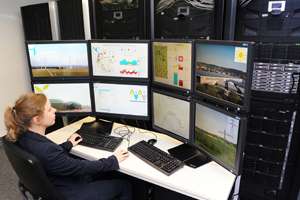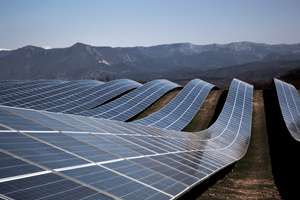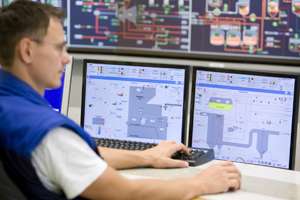The future of networked energy systems

February 1, 2050, is a good day for German electricity consumers. The breeze off the north coast is blowing so strongly that offshore wind farms and the wind turbines on land are running non-stop. Since it's a sunny day, photovoltaic modules, which are mostly located in the south, are also working at peak capacity. On monitors in a central control room, engineers can see from a diagram that, in total, an average of 80 gigawatts (GW) of renewable electricity is being generated, with a midday peak that is as high as 120 GW.
In this scenario, renewable electricity produces enough energy to supply industry, trade, commerce, and households throughout Germany with power derived exclusively from wind and sunlight. The largest consumers are Berlin, Hamburg, and the municipalities in the Ruhr district. But thanks to new transmission lines, densely populated areas such as these have no problem. If at some point there isn't enough wind or the sun isn't out, this scenario includes standby power plants that operate on methane and biogas systems—but they certainly aren't needed today. Staff members in the control room decide that this is an ideal day for replenishing storage systems across the country with excess electricity and using power-to-gas systems to produce methane gas that can be fed into the natural gas lines or turned into electricity again. Can an infrastructure based almost completely on renewable energy provide grid stability and dependability in the same way that fossil-fuel plants do today as demand rises and falls? In other words, are technical solutions up to the task of balancing natural fluctuations in the wind and the sun?
In a joint project called "Combined Power Plant," scientists addressed these questions, and came up with an answer. "It is possible to provide balancing power using 100 percent renewable sources. The crucial factor is a power control system for decentralized plants that is active, intelligent, and accurate to the nearest second," say Siemens researchers Dr. Philipp Wolfrum and Dr. Florian Steinke. That was the finding that emerged from simulations conducted by Siemens Corporate Technology (CT) and its partners from the scientific and business communities.
A Lot of Wind and Sun. In principle, say control system engineers, the renewable energy plants of 2050 really could maintain stable frequency and voltage in the German power grid, assure reliable service, and also produce enough load-balancing energy to always provide precisely the electrical output that is needed at any given time. In their project, they assumed that wind energy would account for the lion's share—in this case 60 percent—of power production. Approximately a fifth would come from photovoltaic systems, and ten percent would come from bioenergy. Hydropower and geothermal energy would account for the remaining ten percent.
The model of this energy supply system was based on the assumption that annual power demand would be of approximately the same as it is today, that is, about 600 terawatt-hours (TWh). The model included additional consumers such as electric cars and new storage technologies, and it also took into account the increases in energy efficiency that are expected by the German federal government, as well as optimizations of industrial systems and processes and possibilities for demand management.
The model also assumed that the Network Development Plan of the German federal government (for the year 2032) will be implemented, so that, for example, future offshore wind farms will be connected to the grid, and the high-voltage direct current lines needed to transport the resulting electricity across large distances will be built—mainly from the north to the south of the country.
On the basis of weather and electricity demand data from 2007, the researchers estimated the power generation and demand of the whole country for every hour of a year, with a spatial resolution of 100 meters by 100 meters. Experts at the Fraunhofer Institute for Wind Energy and Energy System Technology (IWES) conducted extensive analyses of locations, including the possibility of local generation, to identify the spatial distribution of new wind and photovoltaic plants. Load flows in the grid result from renewable energies fed into it, electricity demand, including load management, and the use of power plants and storage systems.
But that by itself is not enough to demonstrate that a power supply is reliable and secure. These days, grid operators have to guarantee what are called "ancillary services." In addition to maintaining stable frequency and voltage, these include congestion management and, in the event of an outage, the rapid restoration of supply. The resulting virtual combined power plant must show that it can provide these services at all times, that it balances supply and demand, and that it can keep the frequency at a steady 50 Hertz, the prevailing value in Europe. This is essential, because deviations can lead to the collapse of electrical networks.

Using simulations, the project's partners were able to determine production peaks, surpluses and deficits, and subject the system to extreme situations, such as the failure of individual lines. The results indicate that voltage and frequency stability, congestion management, and service reliability would be achievable in the envisioned future system.
However, to meet these objectives, some of the project's general technical conditions would have to be adjusted. For example, in the future, inverter-based generators at photovoltaic plants and wind power plants could provide load-balancing power more quickly than is currently demanded by today's systems. This would provide additional stability for the grid and thus compensate for the inevitable reductions in power generation that occur as wind speeds moderate or drop to zero.
But the project's partners didn't limit their studies to simulations—they also examined feasibility issues in a subsequent field trial. For this experiment, they connected four biogas, 36 wind, and 66 photovoltaic plants across Germany. These plants, with a total capacity of approximately 80 megawatts, were managed from a control center in Kassel. In this renewables-based combination power plant, the partners tested the approaches they had come up with and demonstrated that renewable energy plants can be managed as a power pool to meet the technical requirements for supplying load-balancing power.
"Thanks to their modern inverters and converters, solar and wind power plants allow even more freedom of action than synchronous generators connected directly to the grid," say researchers Wolfrum and Steinke. "They allow voltage, phase position, and frequency to be adjusted very effectively. All in all, we were able to demonstrate that system stability was preserved, and how it was preserved." . But the researchers added one proviso: The plan's envisaged paradigm shift in the supply of electric power can succeed only through a massive expansion of storage technologies. This is the only way to offset seasonal fluctuations in wind and photovoltaic output, they said.
Many Storage Units Needed. In view of this, Siemens scientists therefore also used simulations to calculate how to optimize the type, spatial distribution, and use of storage units and flexible generators in the context of their long-term planning. The constraint for these optimizations stipulated that all loads must be perfectly covered at every instant. Today, utility companies use pumped storage reservoirs as buffers. Their efficiency rate is a very high 80 percent, but capacity is nowhere near adequate for the storage of large quantities of energy. Today's pumped storage power plants could supply Germany with energy for barely half an hour—and there aren't enough suitable locations to build more.
As a result, power-to-gas plants will play a crucial role. These plants would use excess renewable electricity to decompose water into its constituents (hydrogen and oxygen) in the chemical process known as electrolysis. Carbon dioxide (CO2) would then be added to produce methane gas. The methane would then power gas and steam turbine power plants directly—and be converted back into electricity with an efficiency rate of more than 60 percent. Methane can replace natural gas, and it can be fed into the public gas grid. The study pointed out that the German natural gas grid can easily handle the storage needs of renewable energy surpluses. Wind and solar power stations would be supplemented by biomass plants in addition to gas-fired power plants. Both can respond quickly and flexibly and can thus be used to balance out fluctuations in power generation. However, researchers have calculated that these power plants must be numerous enough to collectively be capable of reaching approximately the maximum load in Germany. Even if existing gas-fired power plants could be used for this purpose, this would still require the construction of plants capable of generating tens of additional gigawatts, which would be a problematic investment if the plants were needed only a few hundred hours per year.

"In the winter, for example, when there is no wind and the sky is overcast, they would jump in as a reserve and guarantee a supply of power for everyone in Germany," says Wolfrum. "Another challenge lies in storage management. If I know when it will be cloudy or calm, I can fill the various types of storage systems a few days in advance in the right order and discharge them in the optimal way when power is needed."
The project's partners have also calculated what a national renewable energy system would need in terms of added grid construction. Their data show that the grid would have to be expanded only a modest amount beyond the current Network Development Plan of the German federal government. In view of their results, they are convinced that Germany really could be supplied with power from 100 percent renewable sources if the renewable power plants, storage systems, and biogas plants were intelligently integrated.
Monitor, Regulate, Optimize. A prerequisite for this is a powerful communication infrastructure that would allow decentralized renewable energy plants to be monitored and managed in real time. Although such a system would become more complex as a result of this, Steinke says it would be manageable "if you perfect the forecasting and the calculations regarding plant usage. The secret of success is the right mix of renewable plants and the application of optimization techniques and management methods to their operation."
In sum, the crucial characteristic of this grand plan isn't renewable energies. What would have to change is mainly the structure and organization of power generation and distribution. "The shift to a sustainable energy supply is possible if the grid with all its components is expanded, a power storage system is built, and the general framework of the balancing power market is adjusted. That's because right now energy sources that fluctuate can't take part. Since you can only predict a short time in advance when renewable power will be fed into the grid, correspondingly shorter bid periods and lead times will be needed," say Wolfrum and Steinke.
Although it may be difficult to examine the individual components of a 100 percent scenario like this one from a business management point of view, the cost to the economy as a whole appears clear to Professor Hoffmann, head of the Fraunhofer Institute's IWES in Kassel. "We believe the current costs of fossil primary energy in Germany—€83 billion per year for oil, coal, and gas—can be lowered to practically zero over a period of 40 years," he says. "According to our calculations, the break-even point will be reached in 15 to 20 years—the point at which the costs for the expansion of renewable energies and the purchase costs for fossil energy will, when taken together, be less than today's primary energy costs."
Moreover, the analyses of IWES researchers comprise not only the electricity sector but also heating and transportation. The experts also see potential in electric mobility, passenger transport, and heavy goods traffic, such as trolley trucks. According to their ideas, heat pumps should cover about 75 percent of the requirement in the low-temperature range, and increasing use should be made of power-to-heat technology in the industrial sector. Furthermore, they say, power demand could be reduced by 25 percent with efficiency measures, including building insulation and the installation of better heating systems.
Provided by Siemens